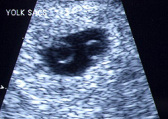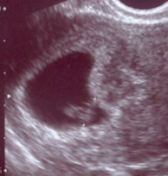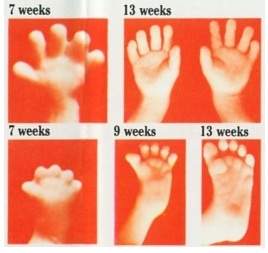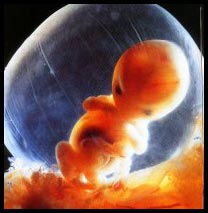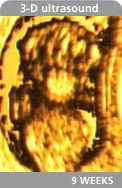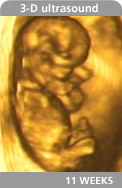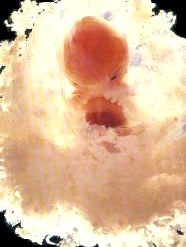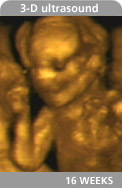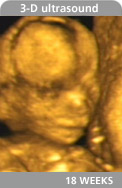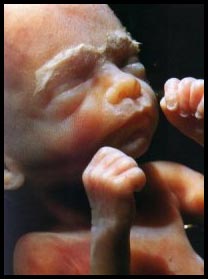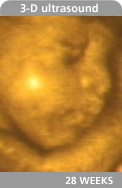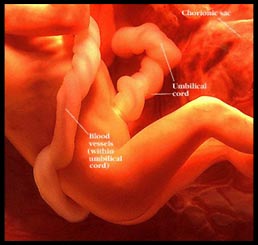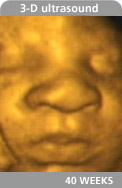|
Fetal Development Conception - 40 Weeks
|
| Week 1 | |||
| Because we are counting with the gestational age method, week one begins with the first day of your menstrual period. Conception hasn't yet occurred, but you already get to start counting. |  |
||
| Week 2 | |||
| Nothing happening with fetal development yet. Your uterus has shed its lining through your period and is now preparing a lush new bed of blood-rich tissue designed to house a growing fetus. Your eggs are ripening in one of the ovaries and preparing to release one. |  |
||
| Week 3 | |||
| Sperm meets egg within the fallopian tube and the miracle of life begins. Although several sperm may penetrate the egg's outer layer, only one sperm will enter the ovum and fertilize it. In the middle of the ovum, the chromosomes of mother and father splash about and bits of information from both begin to form the chromosomes of your baby. At the moment of conception, your baby's gender is determined thanks to the sex chromosomes in the father's sperm. Fertilization, the joining of the sperm and the egg in the fallopian tube (top right) to form a unique human being, occurs. Forty-six chromosomes provide the blueprint for the embryo's physical characteristic
The picture on the right is a fertilized egg only thirty hours after conception. Magnified here, it is no larger than the head of a pin. Still rapidly dividing, the developing embryo, called a zygote at this stage, floats down from the fallopian tube and towards the uterus. Conception is the moment at which the sperm penetrates the ovum. Once fertilized it is called a zygote, until it reaches the uterus 3-4 days later. |

|
||
| Week 4 | |||
| Implantation occurs.
Hormones produced by the embryo stop the mother's menstrual cycle. The blastocyst may float freely in the uterus for about 48 hours before implanting. Blastocyst means "sprout pouch," and these cells begin to divide into two groups - those that form the placenta and those that form the baby. The blastocyst will burrow itself into the lining of the uterus which is called implantation. Upon implantation, complex connections between the mother and embryo develop to form the placenta. |
|
||
| Week 5 | |||
| The embryo's tiny heart begins to beat by day twenty-one. The brain has developed into 5 areas and some cranial nerves are visible. Arm and leg buds are visible and the formation of the eyes, lips, and nose has begun. The spinal cord grows faster than the rest of the body giving a tail like appearance which disappears as the embryo continues to grow. The placenta begins to provide nourishment for the embryo.
The developing embryo has three layers. In the top layer (ectoderm), the neural tube will form which will further develop into the nervous system (brain, spinal cord, skin and hair). In the middle layer (mesoderm), the heart and circulatory system, bones, muscles, kidneys and reproductive organs will develop - eventually. At this stage, however, the heart and primitive circulatory system will rapidly form. In fact, the circulatory system is the first organ system to function. In the inner layer (endoderm), a simple tube will develop into the intestines, liver, pancreas and bladder. |
|
||
| Week 6 | |||
| The embryo is about 1/5 of an inch in length. Growth is very rapid this week. The umbilical cord develops. The eyes and ears begin to form as well as an opening for the mouth. The heart has begun to pump blood and most of the other organs are well under construction. Buds form on the body that will become the arms and legs.
This remarkable photograph of a tiny fetus in its unruptured amniotic sac was taken after surgery for an ectopic pregnancy in 1972. This picture demonstrates the development of a baby at only six weeks after conception. |
|
||
| Week 7 | |||
| The baby is about 1/3 of an inch, the size of a grain of rice. Development of the arms and legs continue although the fingers and toes haven't yet formed. The brain is growing as well as the lenses of the eyes, nostrils, intestines, pancreas and bronchi.
Major organs have all begun to form. The embryo has developed its own blood type, unique from the mother's. Hair follicles and nipples form and knees and elbows are visible. Facial features are also observable. The eyes have a retina and lens. The major muscle system is developed and the embryo is able to move. Arms and hands develop earlier than legs and feet, but by two months, the lines of palms and footprints are already engraved in the skin. Ultrasound photo is twins at seven weeks. |
|
||
| Week 8 | |||
| The embryo is reactive to its environment inside the amniotic sac where it swims and moves. Hands and feet can be seen. At the end of week 8, the embryonic period is over and the fetal stage begins.
An ultrasound done at this stage should show a fluttering heartbeat. Elbows begin to form in the arms and fingers start to develop. The leg buds begin to show feet with tiny notches for the toes. The face continues to change as the ears, eyes and the tip of the nose appear. The intestines start to form in the umbilical cord. Teeth develop under the gums. |
|
||
| Week 9 | |||
| Cartilage and bones begin to form. The basic structure of the eye is well underway and the tongue begins to develop. The intestines start to move out of the umbilical cord and into the abdomen as the body grows and makes room. The fingers and thumb have appeared but are short and webbed. |
|
||
| Week 10 | |||
| The embryo is now about 1 inch in length. Facial features, limbs, hands, feet, fingers, and toes become apparent. The nervous system is responsive and many of the internal organs begin to function.
The baby has begun moving inside the womb although it's too small for mom to notice. Most of the joints are formed now - elbow, wrist, knee, shoulder, and ankle as well as the hands, fingers, feet and toes. |
|
||
| Week 11 | |||
| Starting with this week, the baby is now called a fetus. The most critical part of the baby's development is over. This is a period of rapid growth, and the baby is about an inch or so in length at the beginning of the week and will be about 2 inches by the end of the week. The baby's head is about half its length. The eyelids will fuse shut, and the irises will begin to develop. Sometime during this week or the next week, blood will begin to circulate between the baby and uterus and the placenta starts to function. |
|
||
| Week 12 | |||
| By this point, nearly all of the organs and structures of the fetus are formed. They will continue to grow and develop until delivery. Fingers and toes have separated and hair and nails begin to grow. The genitals begin to take on their gender characteristics. Amniotic fluid begins to accumulate as the baby's kidneys begin to produce and excrete urine. The muscles in the intestinal walls begin to practice peristalsis - contractions within the intestines that digest food. |
|
||
| Week 13 | |||
| As the baby continues to develop, the vocal cords begin to form. The face is looking more and more human each day as the eyes begin to move closer together instead of being on the sides of the head and the ears move to a normal position. It would be possible now to determine the baby's sex by looking at the genitals if we could only get close enough. (We usually can't "guess" via ultrasound until around the 16th week.) The intestines move farther into the baby's body; the liver begins to secrete bile and the pancreas begins to produce insulin.
Arms and hands develop earlier than legs and feet, but by two months, the lines of palms and footprints are already engraved in the skin. |
|
||
| Week 14 | |||
| The baby is a whopping 3 1/2 inches long and is 1 to 2 ounces. The muscles begin to develop and sex organs form. Eyelids, fingernails, and toenails also form. S/he begins to practice inhaling and exhaling movements. The eyes and ears continue to move and develop, the neck is still getting longer, and the baby's chin no longer rests on his/her chest. The hands are becoming functional, and the baby is beginning to learn to move/use them (probably more reflex than anything). At this point, our little one is receiving all of his/her nourishment from the placenta.
You should be able to hear the baby's heartbeat with a doppler. |
 |
||
| Week 15 | |||
| If you have an ultrasound now, you may notice your baby sucking his/her thumb. The bones are getting harder each day. The baby's skin is very thin and transparent; you can see blood vessels through the skin. Lanugo, a very fine hair, covers the body and will continue growing on the baby until around the 26th gestational week of pregnancy. |  |
||
| Week 16 | |||
| If you haven't already, You may begin to feel movement as the baby's bones harden. If you are somewhat overweight, have a thick uterus, and/or if this is your first pregnancy, you may not be feeling baby yet or feeling baby regularly. Don't panic! You will soon. The legs are now longer than the arms, and s/he is moving those arms and legs frequently, especially since there's still lots of room to move within the uterus.
Fingernails and toenails are growing too. In fact, some babies need their nails clipped right after birth! |
|
||
| Week 17 | |||
| This is a period of rapid growth as the fat begins to form underneath the baby's skin. Baby and placenta are about equal in size now. The tiny heart is pumping as much as 25 quarts of blood a day! The reflexes are probably in place now as the baby sucks, swallows and blinks. |  |
||
| Week 18 | |||
|
The baby is now about 5 inches long and nearly half a pound and very human looking. Pads are forming on the fingertips and toes, and the eyes are looking forward rather than out the sides of the head. The child blinks, grasps, and moves her mouth. Hair grows on the head and body. Meconium, the baby's first bowel movement, is accumulating within the bowel. If your baby is a boy, his prostate gland is beginning to develop. |
|
||
| Week 19 | |||
| Along with the lanugo, vernix caseosa forms on the baby's skin. Vernix is a white cheesy substance that protects your baby's skin from its aquatic environment. The placenta continues to grow and nourish the baby. |  |
||
| Week 20 | |||
| "Quickening" (when the mother can feel the fetus moving) usually occurs around this time. Finger and toenails appear. Lanugo, a fine hair now covers the entire body. The fetus can hear and recognize the mother's voice. Sex organs are visible on ultrasound devices.
The baby has as much sleep and awake time as a newborn. The scalp hair begins to grow. If your baby is a girl, her uterus is starting to develop. |
|
||
| Week 21 | |||
| The rapid growth phase begins to slow down this week. The heart grows stronger this week, and the legs are reaching their relative proportions. |  |
||
| Week 22 | |||
| The fetus now weighs approximately 1/2 a pound and spans about 10 inches from head to toe. Sweat glands develop, and the external skin has turned from transparent to opaque. The eyelids and eyebrows are now formed, and the brain begins rapid growth. If your baby is a boy, his testes have begun their descent from the pelvis to the scrotum. |  |
||
| Week 23 | |||
| The baby weighs about a pound now. The body is becoming better proportioned each day, and the bones of the middle ear begin to harden.
If born now, the baby has a chance for survival. |
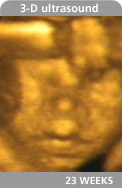 |
||
| Week 24 | |||
| The baby gains about 6 ounces this week as the body begins to fill out. This weight is in muscle, bone mass and the growing organs and tissues. The weight could top 1 1/3 pounds by the end of the week. A protective waxy substance called Vernix covers the skin. By birth, most of the Vernix will be gone but any that is left is quickly absorbed. Fetus has a hand and startle reflex. Footprints and fingerprints are forming. Fetus practices breathing by inhaling amniotic fluid into its developing lungs. |
|
||
| Week 25 | |||
| The structures of the spine - 33 rings, 150 joints and 1000 ligaments - begin to form. The blood vessels of the lungs are developing and the nostrils begin to open.
At 25 weeks there is a 60% chance of survival if born. |
 |
||
| Week 26 | |||
| The baby could weigh about two pounds now and be around 9 inches long (crown of the head to the rump). As the blood vessels in the lungs began last week, the air sacs in the lungs begin this week. The lungs begin to secrete surfactant which covers the inner lining of the air sacs which then allows the lungs to expand normally during breathing. Besides the active lung growth, the brain kicks in with brain wave activity for the visual and auditory systems. | 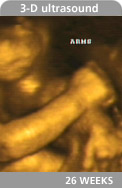 |
||
| Week 27 | |||
| During this week, the brain continues its rapid growth, and the lungs continue to grow. Eyelids begin to open, and the retinas begin to form. The baby will grow over 1/2 inch this week and will be about 1 1/3 feet long (from crown of head to the toes or 9.6 inches from crown to rump). |  |
||
| Week 28 | |||
| The baby is growing and developing at an astonishing rate. Eyebrows and eyelashes are now present, and the hair on the head is growing. The eyelids open, and the eyes are completely formed. The body is getting plumper and rounder (weighs about 2 pounds) and is composed of around 2 to 3% body fat. Muscle tone is gradually improving. The lungs are capable of breathing air but if the baby is born now, it would struggle to properly breathe. The baby can recognize your voice now. The fetus is considered legally viable at 28 weeks and there is a 90% chance of survival if born at this point. |
|
||
| Week 29 | |||
| The baby's head is in proportion to the rest of the body. Fat continues to accumulate under the skin. The brain can control primitive breathing and body temperature control, and the eyes can move in the sockets. The baby is becoming sensitive to light, sound, taste and smell. | 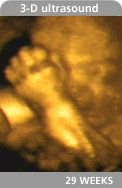 |
||
| Week 30 | |||
| The baby is nearly three pounds already and growing like a weed.
The early lanugo is disappearing, the eyelids open and close, and the toenails are growing. The bone marrow is now responsible for red blood cell production. |
 |
||
| Week 31 | |||
| Growth begins to slow a teeny bit, and the brain goes through a period of rapid development. The only major organ left to fully develop is the lungs. If your baby is a boy, his testes begin to descend from the body cavity to the scrotum. |  |
||
| Week 32 | |||
| The baby is up to four pounds now and all five senses are functional. The toenails are completely formed and the hair on the head continues to grow. |
|
||
| Week 33 | |||
| At this point, the amniotic fluid is at the highest level in the pregnancy. The amount will remain constant until delivery. Rapid brain growth has increased the baby's head size approximately 3/8 of an inch this week. Fat continues to accumulate which turns the baby's skin color from red to pink. |  |
||
| Week 34 | |||
| The baby responds as a newborn with its eyes open while awake and closed while sleeping. S/he is developing immunities to fight mild infection. Those sharp little fingernails are at the ends of the fingertips already, and you might need to clip them during the first few days after birth. |  |
||
| Week 35 | |||
| The average sized baby is around five and a half pounds. The fat accumulations plump up the arms and legs this week. The baby has gotten big enough to take up most of the uterus, and there's less room to move around. The testes have completed their descent in males. | 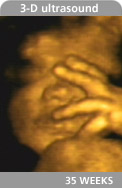 |
||
| Week 36 | |||
| With four weeks to go, our baby is almost ready. S/he could drop into the birth canal at any time now. This week, the fat is dimpling on the elbows and knees as well as forming creases in the neck and wrists. The baby's gums are very rigid. |  |
||
| Week 37 | |||
| Average size is around 6.5 pounds. The baby practices breathing movements preparing for life outside the womb. His/her grasp becomes firm, and s/he will turn toward light. |  |
||
| Week 38 | |||
| The baby may be gaining an ounce a day now. His/her intestines are accumulating lots of meconium (baby's first bowel movement). The circumference of the head and the baby's abdomen are about the same size. |  |
||
| Week 39 | |||
| The average size baby is over seven pounds at this point. Most of the lanugo is gone as the baby prepares for its final womb days. The lungs are maturing and surfactant production is increasing. The baby can't move too much anymore as its womb space has become very crowded. |  |
||
| Week 40 | |||
| The last week (or is it?). The average size newborn is 7.5 pounds and 20 inches long. At this point, most of the vernix is gone, 15% of the body is fat and the chest sticks out. Hair on the baby's head is now coarser and thicker. The lungs are mature. At birth the placenta detaches from the uterus and the umbilical cord will be cut as the baby takes his first breaths of air. Breathing will trigger changes in the heart and bypass arteries forcing all blood to now travel through the lungs.
This marks the end of the normal gestational period. The child is now ready to live outside of his mother's womb. |
|
||
| Information from: http://www.wpclinic.org http://www.pregnancyguideonline.com http://www.babycenter.com |
|||



